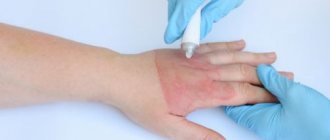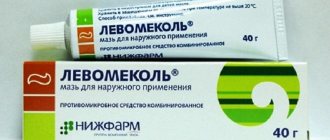Betaderm ointment (0.5mg+1mg)/g 15g No.1
Name
Betaderm ointment for nar. approx. (0.5mg+1mg)/g in tubes 15g in pack No. 1
Description
White or almost white translucent fatty soft mass.
Main active ingredient
Betamethasone+gentamicin
Release form
ointment
Dosage
1 g ointment contains 0.5 mg betamethasone
Pharmacological properties
The drug is for local use. The components of Betaderm ointment have a combined effect in the treatment of inflammatory skin changes occurring with excessive keratosis, allergic etiology, additionally complicated by bacterial infection. Betamethasone dipropionate is a synthetic fluoride derivative of hydrocortisone. Easily penetrates the skin, providing a strong local anti-inflammatory, antipruritic and antiallergic effect. Eliminates the causes of inflammatory processes, prevents the release of histamine and the appearance of local allergy symptoms. Thanks to the local vasoconstrictive effect, it reduces exudative reactions. Betamethasone dipropionate is not biotransformed in the skin. After penetration into the body through the skin, it is biotransformed in the liver and excreted mainly in the urine and, in smaller quantities, in bile. Absorption of betamethasone dipropionate through the skin increases when used on delicate skin in the folds, when used on skin with damaged epidermis or skin damaged by an inflammatory process. In addition, absorption increases with frequent use of the drug or after application over a large surface of the skin. Absorption of betamethasone dipropionate through the skin in young people is more pronounced than in adults. Gentamicin sulfate is a broad-spectrum antibiotic. Shows antibacterial action against gram-negative bacteria and some gram-positive bacteria. Indications for its use in the form of an ointment are secondary infections in skin diseases, if the infection is caused by bacteria sensitive to gentamicin, as well as if such an infection is suspected. Gentamicin sulfate is not absorbed after topical application to intact skin, but after application to skin damaged by trauma, burns and ulcerations, it may be subject to systemic absorption. Gentamicin sulfate is not biotransformed in the body and is excreted unchanged in the urine.
Indications for use
Betaderm in the form of an ointment is used topically for dry inflammatory skin conditions (dermatoses), especially with an allergic onset, complicated by a secondary bacterial infection and occurring with excessive keratoses, itching or severe allergic reactions, mainly in: atopic dermatitis, seborrheic dermatitis, lichen simplex chronicus, keratinizing eczema, psoriasis, allergic contact dermatitis, cutaneous lupus erythematosus, erythema multiforme.
Directions for use and doses
Locally, apply a small amount of ointment to the affected skin surface, 1-2 times a day. The ointment should not be used under an occlusive dressing. If there is an extreme need to apply a bandage, then you should apply a bandage that allows air to pass through and do not use a sealing, oilcloth bandage. Treatment should not be carried out for more than 2 weeks without a break. Do not use more than 45 g of ointment for one week. Use in children Do not use in children under 12 years of age.
Use during pregnancy and lactation
It is not recommended to use Betaderm in pregnant women and during lactation.
Precautionary measures
The medicine should be used only as directed by your doctor. After applying the ointment to the skin, you should not use an oilcloth bandage, which increases the humidity and temperature of the skin. The medicine should be used only for those diseases indicated by the doctor. The patient must inform the doctor about all side effects that occur while using the drug. You should not use the drug for longer than prescribed by your doctor. With long-term use over a large surface of the body, its absorption increases and the incidence of side effects increases, such as edema, hypertension, increased blood glucose, and a decrease in the body's immunological response. If the infection intensifies at the site of application of the ointment, the doctor may apply additional antimicrobial or antifungal treatment. You should adhere to the recommendation and not use the drug on the skin of the face due to the risk of side effects in the form of prolonged dilation of small blood vessels, atrophy of the subcutaneous tissue in the lip area, even after short-term use. Use with caution in pre-existing atrophic conditions of the subcutaneous tissue, especially in the elderly. It is necessary to avoid contact of the drug with the surfaces of the eyes and the skin of the eyelids. Do not use in or around the eyes due to the risk of developing glaucoma and cataracts. Given that corticosteroids and gentamicin are absorbed through the skin, during the use of Betaderm ointment there is a risk of systemic side effects of corticosteroids (suppression of adrenal function) and gentamicin (oto- and nephrotoxicity, especially in people with impaired renal function). Therefore, you should avoid using the drug on large areas of skin, on damaged skin, using in large doses, using in patients with damage to the liver, kidneys, and in children. The drug should be used with particular caution in patients with psoriasis, because topical use of corticosteroids can be dangerous due to tolerance-induced relapse of the disease, the risk of generalized pustular psoriasis, and general toxicity caused by disruption of skin continuity. Avoid contact of the drug with eyes, open wounds and mucous membranes. If the drug gets into your eyes or mucous membranes, it is recommended to rinse them with sufficient water. As with the use of systemic glucocorticosteroids, after external use of the drug, cataracts and glaucoma or a rare disease such as central serous chorioretinopathy (CSC) may develop. Consult your doctor if blurred vision or other visual disturbances occur. Due to the fact that the composition contains cetostearyl alcohol, butylated hydroxytoluene and butylhydroxyaniline, the drug may cause local skin reactions (for example, contact dermatitis).
Interaction with other drugs
During treatment with glucocorticosteroids, smallpox vaccinations should not be administered. You should also not carry out other types of immunization during treatment.
Contraindications
Hypersensitivity to corticosteroids, gentamicin or components of the ointment base. Viral, fungal or tuberculous skin diseases, skin tumors, rosacea and juvenile acne, chicken pox, phlebitis and trophic ulcers. Do not use on areas of extensive skin damage, especially those with a violation of the integrity of the skin, for example, with burns. Do not use on facial skin. Do not use in children under 12 years of age. Do not use the medicine in the anal and genital areas and if the skin around the mouth is inflamed.
Compound
The active ingredient 1 g of ointment contains 0.5 mg of betamethasone (in the form of betamethasone dipropionate) and 1 mg of gentamicin (in the form of gentamicin sulfate). Excipients: liquid paraffin 250 mg, lanolin alcohol 30 mg, cetostearyl alcohol 20 mg, butylated hydroxytoluene 0.05 mg, butylated hydroxyanisole 0.05 mg, white petrolatum up to 1 g
Overdose
With a single use of 7 g of ointment, reversible release of adrenocorticotropic hormone (ACTH) by the pituitary gland may occur as a result of inhibition of the adrenal-pituitary system. With prolonged or inappropriate use, symptoms of Cushing's disease may appear. In this case, it is necessary to discontinue the use of Betaderma ointment. Due to the risk of acute adrenal insufficiency, this should be done under medical supervision. There is also the possibility of systemic side effects of gentamicin, such as hearing loss and the risk of kidney damage.
Side effect
Diseases of the skin and subcutaneous tissue Acne, steroid purpura, inhibition of epidermal growth, atrophy of subcutaneous tissue, dry skin, depigmentation or hyperpigmentation of the skin, atrophy and stretching of the skin, inflammation of the hair follicles, excessive hair growth on the skin, allergic contact inflammation of the skin. Sometimes hives or a rash may appear. After application to the skin of the face, it may cause inflammation around the lips. Endocrine disorders With prolonged use of the drug (more than 2 weeks), when applied to large areas of skin or damaged skin, in the case of closed compresses, as well as in the case of use in children, as a result of increased absorption of betamethasone dipropionate by the circulatory system, general undesirable symptoms may appear caused by the action of corticosteroids. Common undesirable symptoms characteristic of corticosteroids include inhibition of the hypothalamic-pituitary-adrenal system, Cushing's syndrome, inhibition of growth and development in children, hyperglycemia, sugar in the urine, edema, hypertension, decreased immunity. Immune disorders Signs of hypersensitivity may appear. If symptoms of hypersensitivity occur, treatment should be discontinued immediately. Eye diseases After topical application to the skin of the eyelids, sometimes there may be an increase in the symptoms of glaucoma or an acceleration in the development of cataracts. Blurred vision may occur with unknown frequency. Vascular diseases Dilatation of superficial blood vessels may occur. Ear diseases Due to the fact that the drug contains gentamicin, symptoms of ototoxicity may occur, especially if the drug is applied to a large area of skin or to damaged skin. Kidney and urinary tract diseases Due to the fact that the drug contains gentamicin, there is a risk of kidney damage, especially in the case of simultaneous use of nephrotoxic drugs, as well as in cases of kidney disease. If any of the side effects listed above get worse, or you notice any other side effects not listed in the instructions, tell your doctor.
Storage conditions
Store at a temperature not exceeding 25°C. Keep out of the reach of children. Shelf life – 3 years. Do not use the drug after the expiration date.
Betaderm, 1 piece, 15 g, 0.05%+0.1%, ointment for external use
Combined preparation for external use. The properties of the drug Betaderm are due to the combined action of betamethasone dipropionate and gentamicin sulfate.
Betamethasone dipropionate is a synthetic fluorine-containing derivative of hydrocortisone. It has a pronounced anti-inflammatory, antipruritic, antiallergic and vasoconstrictive effect. Reduces the inflammatory process by reducing the production of prostaglandins and leukotrienes, which leads to inhibition of the activity of phospholipase A2 and a decrease in the release of arachidonic acid from phospholipids of cell membranes. It has an antiallergic effect by suppressing local allergic reactions. Due to the local vasoconstrictive effect, it reduces exudative reactions. Reduces protein synthesis, collagen deposition, accelerates the biotransformation of proteins in the skin and inhibits proliferative processes.
Gentamicin sulfate is a broad-spectrum antibiotic from the aminoglycoside group. The bactericidal effect is due to disruption of the structure and function of the cytoplasmic membrane, disruption of RNA synthesis at the level of the 30S ribosomal subunit. Active against gram-positive bacteria: Streptococcus spp. (susceptible strains of group A beta- and alpha-hemolytic streptococcus), Staphylococcus spp. (coagulase-positive, coagulase-negative and some penicillinase-producing strains); against gram-negative bacteria: Escherichia coli, Proteus spp., Pseudomonas aeruginosa, Klebsiella spp., Enterobacter spp., Serratia spp., Citrobacter spp., Salmonella spp., Shigella spp.
Pharmacokinetics
Suction
Betamethasone dipropionate is a lipophilic substance and is easily absorbed through the stratum corneum of the skin without undergoing biotransformation. Absorption increases when applied to skin in the area of body folds, to skin with damaged epidermis or to areas of inflammation, with frequent use of the drug or after application to a large surface of the skin. Absorption of betamethasone dipropionate through the skin is faster in children than in adults.
Gentamicin sulfate is not absorbed after application to intact skin. When applied to affected skin, it can be absorbed into the bloodstream.
Metabolism and excretion
Betamethasone dipropionate is biotransformed mainly in the liver. In the form of compounds with glucuronic acid and in small quantities unchanged, it is excreted mainly in the urine and in smaller quantities in bile.
Gentamicin sulfate is not biotransformed in the body and is excreted unchanged in the urine.



